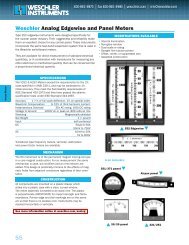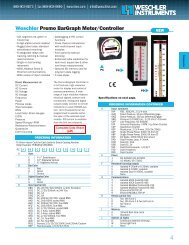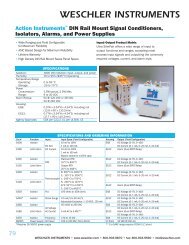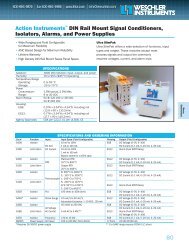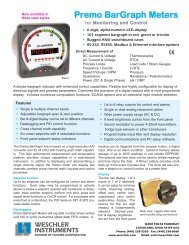WWW.MEGGER.COM
A practical guide to earth resistance testing - Weschler Instruments
A practical guide to earth resistance testing - Weschler Instruments
Create successful ePaper yourself
Turn your PDF publications into a flip-book with our unique Google optimized e-Paper software.
Fall-of-Potential Method: This three-terminal test is the methoddescribed previously with reference to Fig. 10. With a four-terminal tester,P 1 and C 1 terminals on the instrument are jumpered and connected tothe earth electrode under test. With a three-terminal instrument, connectX to the earth electrode.Although four terminals are necessary for resistivity measurements, theuse of either three of four terminals is largely optional for testing theresistance of an installed electrode. The use of three terminals is moreconvenient because it requires one lead to be connected. The trade-off isthat the resistance of this common lead is included in the measurement.Normally, this effect can be minimized by keeping the lead short, toaccommodate simple test requirements. The small additional resistancethus introduced is negligible. When performing more complex tests ormeeting stringent requirements, however, it may be better to use all fourterminals by a lead from the P 1 terminal to the test electrode (connectingit inside the lead from C 1 ).This is a true four-wiretest configuration whicheliminates all lead resistancefrom the measurement.The added accuracy mayprove significant whenmeeting very low resistancespecifications or using testmethods that necessitate anextra digit of measurementin order to meet themathematical requirements.The decision is optional,based on the operator’stesting goals and themethod used. The drivenreference rod C should beTypical use of a Megger digital ground resistancetester to perform fall-of-potential testingplaced as far from the earth electrode as practical; this distance may belimited by the length of extension wire available, or the geography of thesurroundings (see Fig. 11). Leads should be separated and “snaked,” notrun close and parallel to each other, to eliminate mutual inductance.Potential-reference rod P is then driven in at a number of points roughlyon a straight line between the earth electrode and C. Resistance readingsare logged for each of the points. A curve of resistance vs. distance, likeFig. 10b, is then drawn. Correct earth resistance is read from the curve forthe distance that is about 62 percent of the total distance from the earthelectrode to C. In other words, if the total distance is D, the 62 percentdistance is 0.62D; for example, if D is 120 ft, the distance value for earthresistance is 0.62 x 120 or 74 ft.There are three basic types of the Fall-of-Potential test methods and anumber of related test methods that will be described in the appendices.The types of Fall-of-Potential are:n Full Fall-of-Potential — a number of tests are made at different spacesof P and the resistance curve is plotted.n Simplified Fall-of-Potential — three measurements are made at defineddistances of P and mathematical calculations are used to determine theresistance (to be described in more detail later).n 61.8% Rule — a single measurement is made with P at a distance61.8% (62%) of the distance between the electrode under test and C.The related test methods tend to be more complex and sophisticatedrequiring many measurements and/or a great deal of math. Thesemethods have been developed to help overcome the problems facedwhen testing large ground systems or when there is limited space. A list ofthese methods follows:n Intersecting curves method (Appendix IV, page 58)n Slope method (Appendix V, page 62)n Four-potential method (Appendix VI, page 65)n Star delta method (Appendix VII, page 67)28 1-866-254-0962 www.megger.com Getting Down to Earth 29



